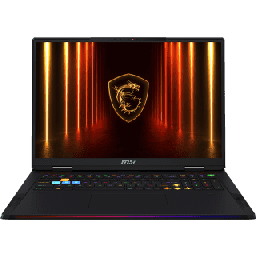MSI Raider A18 HX A9W Review – The Bottleneck Resolver

Introduction

MSI has been making gaming laptops for a long time, and they offer a wide range of devices. They go from simple, all-plastic 15-inch models to 18-inch giants like the one we’re looking at today. It’s called the MSI Raider A18 HX A9W and relies on the mighty 16-core AMD Ryzen 9 9955HX3D. This CPU features second generation AMD 3D V-Cache technology, and if you’re into tech you’ll know this offers superb gaming performance, the desktop counterparts which use the same silicon have proven this.

When I previously reviewed the Razer Blade 16 (2025) with a Ryzen AI 9 HX 370 and RTX 5090, I noticed that the GPU wasn’t being fully utilized in some games, particularly at resolutions lower than 4K. This was evident when compared to the SCHENKER KEY 18 Pro (E25), which had an Intel CPU and the same graphics card. Yes, that’s a bottleneck caused by the processor. Even the Intel system struggled in some scenarios, for instance in games like Baldur’s Gate 3, where the 4K FPS was nearly identical to the 1440p result.
What I’m trying to explain is that if you get a system with an GeForce RTX 5090/5080, you may experience non-optimal gaming performance on 1600p/1440p resolution (or if DLSS Performance/Ultra Performance is applied) if the CPU isn’t punchy enough. You’re spending a fortune on a high-end laptop, and a GPU bottleneck means you’re literally wasting money. This is where the Fire Range-HX CPU with its 128 MB L3 3D V-Cache comes into play. After spending a few days playing with this gem, I can confirm that I have fallen in love with its performance.
The Raider A18 HX A9W is a high-end machine, and that’s why you can find it only with high-refresh-rate IPS displays. For starters, you can choose between two 1200p units with 144 Hz/165 Hz. These two screens are a decent choice if you mainly play competitive titles like CS2 or Call of Duty at low resolution and details to minimize input lag, and they’ll save you a bit of money. Speaking of which, in these described conditions, the 9955HX3D will help a lot to push the FPS as high as possible. But let’s get back to the screen options. The 1600p 240 Hz model is maybe the sweet spot in terms of budget and crisp picture. For those with thicker wallets, MSI has prepared two 2400p panels; one regular IPS with a 240 Hz refresh rate, and the top dog is a 120 Hz Mini LED unit that supports DisplayHDR 1000.
Moving to potential upgrades it seems that everything is okay here. You get a pair of DDR5 SODIMM and two M.2 slots, one of which supports Gen 5 SSDs. The Wi-Fi 7 + Bluetooth v5.4 connectivity is up to par, and for those who prefer a wired connection, there’s also 2.5 GbE LAN.
For security, you even get a fingerprint reader, which is an unusual but welcome addition for a gaming laptop. Other features include an IR webcam, fTPM 2.0, a privacy shutter, Kensington Lock, and Microsoft Pluton Security. Note that some laptops are configured with dTPM 2.0.
Under the bonnet, you’ll find a hefty 99.99 Wh battery to power the thirsty hardware. This reminds me that the GeForce RTX 5090 and 5080 come with a generous 175 W TGP, and the 12 GB RTX 5070 Ti offers a 140 W power limit.
Audiophiles aren’t left behind, as a combination of four 2 W speakers and two 2 W woofers is hidden inside the chassis. Last but not least, the premium gaming experience is boosted by a per-key RGB keyboard by Steelseries and a rich port selection.
Specifications
| Specifications | |
|---|---|
| Manufacturer: | MSI |
| Model: | Raider A18 HX A9W |
| Weight: | 3.60 kg |
| Processor: | AMD Ryzen 9 9955HX3D / Fire Range-HX 16 Cores / 32 threads up to 5.4 GHz, 128 MB L3 cache 55 W Default TDP |
| Chipset: | AMD Promontory/Bixby FCH |
| Display: | Default Display: 18.0″ / 1920×1200 (16:10) / IPS / 144 Hz Optional Display: Optional Display: Optional Display: Optional Display: |
| Operating System: | Windows 11 Pro / Windows 11 Home |
| Integrated Graphics: | AMD Radeon 610M |
| Dedicated Graphics: | NVIDIA GeForce RTX 5070 Ti (mobile): 12 GB GDDR7, 192 Bit, 2000 MHz effective clock 5888 CUDA Cores 184 TMUs 64 ROPs 46 RT Cores 184 Tensor Cores L1: 5.8 MB, L2: 48 MB Up to 140 W TGP NVIDIA GeForce RTX 5080 (mobile): NVIDIA GeForce RTX 5090 (mobile): |
| Memory: | 2x SO-DIMM RAM slots Up to 96 GB of DDR5 at 5600 MT/s |
| Storage: | 1x M.2 2280 PCI Express 5.0 x4 / 1x M.2 2280 PCI Express 4.0 x4 |
| Optical Drive: | None |
| Connectivity: | 2x 5 Gbps USB Type-A / 3.2 Gen. 1 1x 10 Gbps USB Type-A / 3.2 Gen. 2 2x 40 Gbps USB4 / Thunderbolt 4 with DP and PD 3.1 SD Card reader 1x HDMI 2.1 Audio combo jack LAN DC-in |
| Communications: | Wi-Fi 7 + Bluetooth 5.4 1080p IR HDR webcam |
| Audio: | 4x 2 W speaker + 2x 2 W woofers sound by Dynaudio, support for Nahimic and Hi-Res Audio |
| Input device: | Multitouch touchpad Per-Key RGB Gaming Keyboard by SteelSeries |
| Power: | 1x 400 W AC adapter 99.99 Wh battery |
| Warranty: | Two years |
| MSRP: | Starting at $3799 for the RTX 5080-based models |
